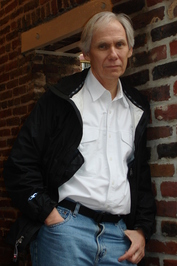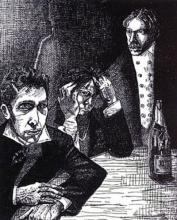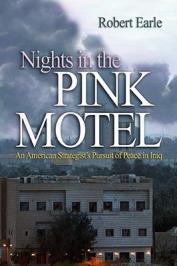S. TREMAINE NELSON interviews ROBERT EARLE

SN: Your short story “Doleo Ergo Sum,” which appears in Issue 4 of The Common, features several characters from The Brothers Karamazov. When did you first read Dostoevsky?
RE: I first read Dostoevsky when I was seventeen. Crime and Punishment was on my high school’s summer reading list. I’ve been reading him ever since. He was an extraordinarily complex literary genius, a man of great flaws, great faith, and great energy. When you go into his world, you’re there from the first page to the last.
SN: Would you consider your story historical fiction or an homage to Dostoevsky? Or perhaps literary fan-fiction?
RE: I think of everything I write as literary fiction, whether it has roots in historical events or literary phenomena. I use history extensively but don’t feel excessively tied down to it. For me, literature possesses its own reality, and that’s what literary-minded writers seek to explore. We don’t write “about” things; we use words and stories to create unique experiences for readers of our work.
That’s what Dickens and Styron and Faulkner and countless others have done for me. In the case of “Doleo Ergo Sum” and its sister tales (there are sixteen altogether), I definitely have enjoyed taking some of Dostoevsky’s characters beyond The Brothers Karamazov. That’s what he wanted to do. Unfortunately, he died before he could put his ideas on paper.
SN: Your novella Thank You, No. We’re Well, following in a series of post-Karamazov stories, was recently released by The Piker Press. How did this project get started? How did you decide to take it beyond its first story?
RE: The whole post-Karamazov cycle got its start when I wrote a story called “The Ashtray” (published in Green Hills Literary Lantern) about Chekhov, one of my favorite writers. In “The Ashtray” I discovered that I could “throw my voice,” as it were, meaning that I have read so much Russian fiction I can imitate its rhythms and locutions and really enjoy doing it. From there I went to the first post-Karamazov story, “Chekhov’s Confession” (published in The Puritan). Again Chekhov played a leading role, but so did Alexei and Dmitri Karamazov.

Artist: Stephanie Rodriguez
After that, I wrote “Doleo Ergo Sum,” bringing Ivan Karamazov into the picture. Soon I was developing the next generation and the generation after that and the generation after that. The texturing and ironies of multi-generational fiction fascinate me. I wouldn’t say all these stories and novellas “wrote themselves,” but once I was off, I was off. Every time I finished one story, the next one came calling on me at about four in the morning, when I usually wake up and start experiencing a kind of imaginative free-fall.
SN: In the way that Dostoevsky’s art has lasted more 130 years, what American writers do you hope people will be reading in 2042?
RE: My list goes this way: William Faulkner, Flannery O’Connor, Willa Cather, some of John Updike, some of Philip Roth, Cormac McCarthy, Walker Percy, William Gass, William Styron, and Wallace Stegner. If we add Canadians to the mix, I’d include Alice Munro and some of Margaret Atwood.
SN: You mentioned you’ve spent the last 25 years living overseas. Would you mind telling us a little about your work?
RE: For most of the time, I was a Foreign Service Officer directing information and cultural programs, including Fulbright commissions, youth exchanges, libraries, speaker series, and media relations. My agency was the U.S. Information Agency, and I was posted in Bolivia, Ecuador, Spain, Mexico, and Germany. Now the U.S. Information Agency is a part of the State Department, which I think is a mistake. There needs to be some room for cultural and intellectual activities to flourish independent of foreign policy constraints.
My colleagues and I maintained contacts throughout society; we had our own budget authority, our own facilities, and the ability to keep up relations with people traditional diplomats tended not to cultivate. Two examples from Mexico: Octavio Paz and Carlos Fuentes. We didn’t deviate from foreign policy positions, but we definitely enriched them.
SN: How has “place” impacted your work?
RE: I feel at home anywhere, but my spirit is most free in New Mexico, where I set a large portion of my first novel, The Way Home. I’ve spent a lot of time in that multi-cultural, beautiful state, and I love just about everything to be found there. I’d say I really know Spain well but have not written about it and am not sure why. There are a lot of different places I’ve built into my post-Karamazov stories: London (love it), San Francisco (love it), New York City (fascinated by it but don’t love it), Berlin (intrigued by it but don’t love it), and Dostoevsky’s imaginary Skotoprigonyevsk (a very difficult place). Place does get under my skin. One thing I rue is that I write inside; I’m much more “me” outside hiking in the woods, or kayaking on a river, or riding my bike just about anywhere.
SN: Can you elaborate a little more on how your travels have impacted your writing?
RE: I have learned to be at home anywhere in the world, and I see the world as one world, just as I see literature as the world’s literature with multiple influences effortlessly crossing borders that do nothing to impede the imagination. If I want to write about a place or time I have not experienced, it isn’t hard for me to put myself there. I’ve mastered a number of languages, largely gotten over the typical American’s ethnocentricity, and feel free to travel mentally even when I’m here in Virginia physically.
SN: How many languages do you speak and what are they?
RE: I speak and read Spanish and German. When I was in high school I had five years of Latin and three of Greek, so I was able to read all the major classical authors in the original, but of course, they are not languages anyone speaks anymore.
SN: Where was your most dangerous assignment in the Foreign Service?
RE: In 2004 I had retired from the Foreign Service but was asked to come back to assist in returning sovereignty to Iraq at the end of our occupation. The insurgency was spiking and we weren’t even certain about whom we were fighting…or why. I functioned as a strategist, helping coordinate the political, military, and economic dimensions of our efforts. The danger level was breathtaking. There was plenty of rough stuff earlier in my career, but in Iraq the Foreign Service entered an entirely new level of engagement. Previously, we would have been pulled out of a country that turbulent, not sent to serve there. Mortar fire, bullets, car bombs, and rockets were a feature of daily life and so were improvised explosive devices (IEDs). I was trained to use automatic weapons, shotguns, and handguns for self-protection and issued substantial body armor as well.
At one point I was evacuated from Baghdad on a litter with a life-threatening medical condition and then was foolhardy or stubborn enough to go back because the ambassador and commanding general wanted me on board. This sort of thing has continued to happen in Afghanistan, and of course, it is what cost the lives of the ambassador and his colleagues in Benghazi, Libya.
SN: Have you written about Iraq?
RE: I wrote a nonfiction book about my experiences in Iraq called Nights in the Pink Motel: An American Strategist’s Pursuit of Peace in Iraq (Naval Institute Press). It’s all fact, but I wrote it more or less as an episodic novel. I wanted to give non-military readers insight into the difficulties that resulted from the U.S.-led invasion of Iraq…what it felt like…what we saw…heard…worried about…said to one another and went through. I used fictional names for all the characters except the most well-known figures and myself, and I’m particularly proud that the people I described — diplomats, soldiers, civilian personnel — all have reacted more or less by saying, “That’s it! That’s how it was!” I find that very gratifying. Again, non-military readers encounter many dramatic stories featuring military battles, skirmishes, raids, rescues, and the like. They seldom see inside the strategic planning and coordinating function of the U.S. government engaged in trying to turn war into peace. In the end, we accomplished a lot during my time in Iraq, capped by the first democratic election in Iraq’s history, but the administration in Washington turned a deaf ear to our analysis of how much more violence, conflict and sacrifice still awaited us. That was a huge, costly, tragic mistake.

SN: Many government personnel write non-fiction, but fewer seem drawn to fiction writing. Have you observed any relationship between political ambition and creative ambition?
RE: Political ambition extinguishes creative ambition with very few exceptions. Why? Because politics is about setting limits to things, negotiating agreements, making compromises, and nudging “reality” forward, if possible, in tiny little increments. Creative ambition won’t put up with that; if you’re creative, you’re a risk taker who wants more, much more. You write because that’s what you were born to do and you won’t compromise, give up, or give in. Politics, in a sense, is a socially “agreed” activity. Art isn’t. A true politician has a very tough time dealing with that daily free-fall of the imagination I alluded to earlier. A true artist has a very tough time simply developing an audience and making a living.
SN: You live in Arlington, Virginia. Why isn’t there a so-called “Great D.C. Novel,” or is there and we’re just not talking about it?
RE: There is no “Great D.C. Novel.” Lately I’ve been working on a series of D.C. stories that partially explain why: D.C. is a truly bizarre place — vanilla on the outside, tarantulas, snakes, and howling monkeys on the inside.
I’ve lived in and around D.C. for thirty years or so because it’s been my home base between foreign assignments. The arrogance, naiveté, pretension, and sheer mass of the federal government (all three branches plus the Beltway Bandits and lobbyists and NGOs, etc.) is wild. I’ve met more certifiable nuts here than anywhere else, many in high office. I sometimes tell myself that I should write the “Great D.C. Novel” and maybe I’ll give it a try. For now, I’m just writing these biting stories, nipping at D.C.’s heels, I guess.
SN: What are you working on today?
RE: Today I happened to be polishing a post-Karamazov novella called The Mountain, which focuses on Alexei Karamazov’s son, Aaron, and his daughter, Deborah. Now I’ve got to go in search of a publisher who’ll take it on. Suggestions are welcome.
SN: Any advice for young writers?
RE: If you want to write, you have to write. It’s best to try to write almost every day, and it doesn’t hurt to start out by listening and observing to what’s going on around you in your daily life and recording your impressions in a journal. Details, phrases, names…lots of little things can enliven what you write and fire your imagination. Creative writing, as it’s sometimes called, requires a great deal of exploratory thinking — what if this? what if that? — and generates lots of dead ends. That’s okay; if you write, you fail; if you fail profoundly enough, you ultimately push through the encrusted conventions in your mind and get into regions that are fascinating and exciting. In many ways the best writing emerges from extended encounters with the unknown and unfamiliar dimensions of your being. If you have a passion for such experiences and such bold self-expression, you’ll find your way ahead.
S. Tremaine Nelson is a graduate of Vanderbilt University and founder of The Literary Man book blog.
Robert Earle has degrees in literature and fiction writing from Princeton and Johns Hopkins. For twenty-five years, he was a diplomat, serving in Latin America, Europe, and the Middle East. His short stories have been published in, among others, Ellipsis, Iron Horse Literary Review, Mississippi Review, Inkwell, and Pangolin Papers. He lives in Arlington, Virginia.



